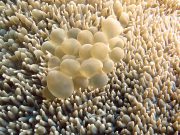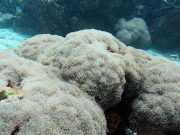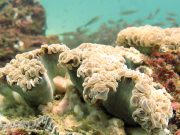Dykning med Bubbelkoraller
Lanta Marina Liv | Euphyllidae
Det finns flera arter av bubbelkoraller som finns i Indo-Stillahavsområdet, varav några kan vi hitta här på dykplatserna runt Koh Lanta.
Bubbelkoraller kan misstas för mjukkoraller, men de har ett hårt, stenigt skelett strax under ytan. 'Bubblorna' kallas vesiklar och blåses upp med vätska under dagen för att fånga solljuset för fotosyntesen. Under natten töms vesiklarna på vätska och dras tillbaka, varpå de ätande tentaklerna kommer fram.
Individer av samma art kan se lite olika ut, beroende på hur stora vesiklarna (bubblorna) är och i vilken miljö de finns, men de är ganska lätta att identifiera eftersom alla arter som finns på våra dykplatser är helt olika varandra och har distinkta vesiklar och skeletttillväxt.
2 arter finns på denna sida:
Grape Coral
(Plerogyra sinuosa)
Grape Corals are easy to identify and are very abundant at the dive sites and reefs around Koh Lanta. This species forms small to very large colonies in both shallow, and deeper water.

Plerogyra sinuosa @ Koh Bida
During the day, Grape Coral colonies show inflated, grape-sized, bubble-like, vesicles which are almost transparent and are filled with the symbiotic algae zooxanthellae.
During the day, these vesicles are exposed to sunlight, producing oxygen and food for the coral polyps.

Hawksbill Turtle's favourite food @ Koh Rok
Grape Coral vesicles are inflated or deflated depending on the amount of light available and colonies can look quite different depending on the level of inflation. At night, Grape Coral vesicles are deflated and retracted, with the feeding tentacles then extended to catch plankton.
The skeleton of Grape Coral colonies forms inverted cones of meandroid winding ribs and valleys which can be seen when the vesicles are retracted, or when part of the colony is damaged/broken.
Hammer Coral
(Euphyllia ancora)
Hammer Coral has puffy tubular polyps with T-shaped tips which are extended both day and night to varying lengths, but cannot be retracted, making this an easily identified coral species. The polyp tips contain zooxanthellae and vary in colour from a light cream through to orange, green and brown.

Euphyllia ancora colonies @ Koh Haa
Hammer Coral polyps are arranged in meandroid rows, usually in colonies up to a meter across.
At some dive sites such as Koh Haa and Koh Rok, multiple colonies form together to cover many meters of substrate. Hammer Coral polyps can give a nasty sting if touched by humans.

Euphyllia ancora @ Koh Haa
As with other bubble coral species, Hawksbill Turtles love to eat Hammer Coral polyps.

Euphyllia ancora @ Koh Haa
Dykning med Bubbelkoraller runt Koh Lanta
Dykning och Snorkelutflykter
Om du vill ha en chans att se Bubbelkoraller på en av våra dagliga högsäsongs dykresor från Koh Lanta, skicka oss ett e-postmeddelande till info@diveandrelax.com.
Följ med på våra dykresor med speedboat under högsäsong till några av Thailands bästa dykplatser och njut av små grupper, korta restider och fokus på personlig service, säkerhet och nöje.
Är du ännu inte certifierad dykare? Lär dig att dyka på Koh Lanta med den 3-dagars SSI Open Water Diver-kursen.
Boka online och spara 10 % på dykresor och dykkurser på Koh Lanta.
Ta Reda på Mer
Guider för Marina Djur och Växter i Indo-Stilla Havet
- Allen, G., Steene, R., Humann, P., DeLoach, N. (2003) Reef Fish Identification, Tropical Pacific. Jacksonville, FL., USA: New World Publications, Inc., ISBN 1-878348-36-1.
- Humann, P., DeLoach, N., (2010) Reef Creature Identification, Tropical Pacific. Jacksonville, FL., USA: New World Publications Inc., ISBN 978-1-878348-44-9
- Debelius, H. (2013) Indian Ocean Reef Guide. Frankfurt, Germany: IKAN - Unterwasserarchiv, ISBN 978-3-939767-52-7.
- Debelius, H. (2004) Nudibranchs and Sea Snails, Indo-Pacific Field Guide. Frankfurt, Germany: IKAN - Unterwasserarchiv, ISBN 3-925919-51-1
- Erhardt, H., Knop, D. (2015) Corals Indo-Pacific Field Guide. Frankfurt, Germany: IKAN - Unterwasserarchiv, ISBN 3-925919-69-4.
- Veron J.E.N., Stafford-Smith M.G., Turak E. and DeVantier L.M. (2016). Corals of the World
